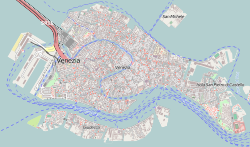| Great German Synagogue | |
|---|---|
Italian: Scuola Grande Tedesca | |
 The former synagogue, now Jewish museum, from the square of the Ghetto Nuovo, in 2017 | |
| Religion | |
| Affiliation | Orthodox Judaism (former) |
| Rite | Nusach Ashkenaz |
| Ecclesiastical or organisational status |
|
| Status |
|
| Location | |
| Location | Jewish Ghetto, Venice |
| Country | Italy |
Location of the former synagogue in Venice | |
| Coordinates | 45°26′42.443″N12°19′37.272″E / 45.44512306°N 12.32702000°E |
| Architecture | |
| Type | Synagogue architecture |
| Completed | 1528 |
| Materials | Stone |
| [1] | |
The Great German Synagogue (Italian : Scuola Grande Tedesca) is a former Orthodox Jewish congregation and synagogue, that is located in the Jewish Ghetto of Venice, Italy. Completed in 1528, it is the oldest Venetian synagogue, and one of five synagogues that were established in the ghetto. [2] [3]
Contents
Ceased operating as a synagogue in 1917, the former synagogue building was restored between 2016 and 2017 by the World Monuments Fund. [4] No longer used for regular worship, it is open to the public as a Jewish museum through the Jewish Museum of Venice.




